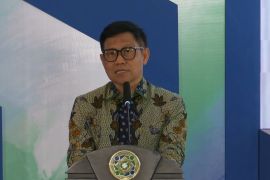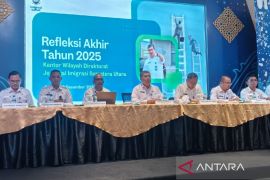Than with Twice-daily Aspart Premixed Insulin
PARIS, Sep. 12 (ANTARA/PRNewswire-AsiaNet) --
- First Randomized Controlled Trial to Show That Basal Plus Regimen Provides more Effective Glycemic Control with Less Hypoglycemia Than with Aspart Premixed Insulin
Sanofi (EURONEXT: SAN and NYSE: SNY) announced today data presented at the 47th Annual Meeting of the European Association for the Study of Diabetes to show that adding mealtime Apidra(R) (insulin glulisine) to Lantus(R) (insulin glargine) is more efficacious, with less hypoglycemia, than introducing aspart premixed insulin twice daily.
"Comparison of 3 intensified insulin regimens added to oral therapy for type 2 diabetes: twice-daily aspart premixed vs glargine plus 1 prandial glulisine or stepwise addition of glulisine to glargine" [ABSTRACT 3515]
Results from the All-to-Target trial show that people with type 2 diabetes, whose treatment with oral antidiabetic therapy is unsuccessful, may advance to intensified insulin treatment. Adding mealtime Apidra(R) insulin to a Lantus(R) basal-insulin regimen is an effective treatment strategy for insulin intensification, sustaining continuity of care throughout the duration of the disease.
The stepwise addition of Apidra(R) prandial (mealtime) doses to Lantus(R) treatment can also be an effective introduction to a full basal-bolus regimen.
All-to-Target is a 60-week, randomized, open-label study comparing efficacy, hypoglycemia rates and body weight in people with type 2 diabetes treated with three different insulin regimens: premixed 70/30 protamine-aspart/aspart twice daily (n = 192); Lantus(R) plus one prandial dose of Apidra(R) (n = 189); and Lantus(R) plus stepwise addition of Apidra(R) (n = 191).
Significantly more people reached target HbA1c<7% with one mealtime dose of Apidra(R) plus Lantus (49%, p<0.025), or stepwise addition of Apidra(R) at mealtimes (45%, p<0.05), than those on premixed insulin (39%). Furthermore, significantly more people on one mealtime dose of Apidra(R) plus Lantus(R) (24%, p<0.05) or stepwise addition of Apidra(R) at mealtimes (24%, p<0.05) achieved target HbA1c with no hypoglycemia vs. those on aspart premixed insulin (14%).
People on the Basal Plus regimen experienced fewer hypoglycemic events (blood glucose <50 mg/dL [2.8 mmol/L] + symptoms per patient year [Glarg +1 glulisine = 0.8+/-0.2; p>0.001 and Glarg+0-3 glulisine = 0.9+/-0.2; p<0.001] vs. premixed [1.9+/-0.3]).
The Basal Plus approach not only emulates physiological insulin secretion but also allows the flexibility of separate adjustment of basal and prandial insulin doses.
Commenting on the results, study investigator Dr Matthew Riddle, Oregon Health & Sciences University, said: "Adding a single injection of prandial insulin to titrated basal insulin is a logical and patient-friendly way to intensify therapy for type 2 diabetes. Now we have shown this approach was as effective, yet caused less hypoglycemia than twice-daily premixed insulin. In addition, this basal plus one prandial injection method compared favorably as a regimen permitting full basal-bolus treatment."
First data from the trial have previously been presented at the American Diabetes Association's 71st Scientific Sessions, 2011.
About the Sanofi Diabetes Division
Sanofi strives to help people manage the complex challenges of diabetes by delivering innovative, integrated and personalized solutions. Driven by valuable insight that comes from listening to and engaging with people living with diabetes, the Company is forming partnerships to offer diagnostics, therapies, services and devices. Sanofi markets both injectable and oral medications for people with type 1 or type 2 diabetes. Investigational compounds in the pipeline include an injectable GLP-1 agonist being studied as a single agent, in combination with basal insulins, and/or in combination with oral antidiabetic agents.
About Sanofi
Sanofi, a global and diversified healthcare leader, discovers, develops and distributes therapeutic solutions focused on patients' needs. Sanofi has core strengths in the field of healthcare with seven growth platforms: diabetes solutions, human vaccines, innovative drugs, rare diseases, consumer healthcare, emerging markets and animal health. Sanofi is listed in Paris (EURONEXT: SAN) and in New York (NYSE: SNY).
Forward Looking Statements
This press release contains forward-looking statements as defined in the Private Securities Litigation Reform Act of 1995, as amended. Forward-looking statements are statements that are not historical facts. These statements include projections and estimates and their underlying assumptions, statements regarding plans, objectives, intentions and expectations with respect to future financial results, events, operations, services, product development and potential, and statements regarding future performance. Forward-looking statements are generally identified by the words "expects", "anticipates", "believes", "intends", "estimates", "plans" and similar expressions. Although Sanofi's management believes that the expectations reflected in such forward-looking statements are reasonable, investors are cautioned that forward-looking information and statements are subject to various risks and uncertainties, many of which are difficult to predict and generally beyond the control of Sanofi, that could cause actual results and developments to differ materially from those expressed in, or implied or projected by, the forward-looking information and statements. These risks and uncertainties include among other things, the uncertainties inherent in research and development, future clinical data and analysis, including post marketing, decisions by regulatory authorities, such as the FDA or the EMA, regarding whether and when to approve any drug, device or biological application that may be filed for any such product candidates as well as their decisions regarding labeling and other matters that could affect the availability or commercial potential of such products candidates, the absence of guarantee that the products candidates if approved will be commercially successful, the future approval and commercial success of therapeutic alternatives, the Group's ability to benefit from external growth opportunities as well as those discussed or identified in the public filings with the SEC and the AMF made by Sanofi, including those listed under "Risk Factors" and "Cautionary Statement Regarding Forward-Looking Statements" in Sanofi's annual report on Form 20-F for the year ended December 31, 2010. Other than as required by applicable law, Sanofi does not undertake any obligation to update or revise any forward-looking information or statements.
Contacts:
Global Diabetes Division Communications
Dr. Tilmann Kiessling
T. +49(0)172-61-59-291
tilmann.kiessling@sanofi.com
SOURCE: Sanofi
Editor: PR Wire
Copyright © ANTARA 2011











